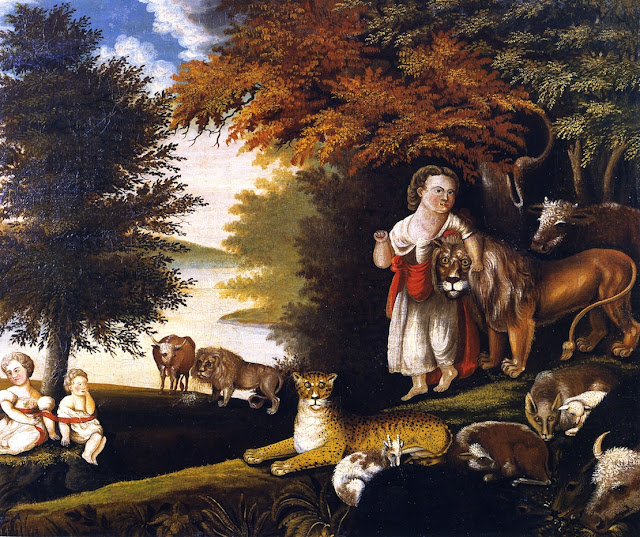Edward Hicks (1780 – 1849) was an American folk painter and
distinguished minister of the Society of Friends. He became a Quaker icon
because of his paintings.
For full biographical notes on Hicks, and for earlier works, see part 1 also.
For full biographical notes on Hicks, and for earlier works, see part 1 also.
At
first glance a lot of these images look the same, but they were painted
over many years and each has subtle differences and nuances.
This is part 2 of a 2-part post on the works of Edward Hicks:
This is part 2 of a 2-part post on the works of Edward Hicks:
 |
| 1837 Peaceable Kingdom oil on canvas Private Collection |
 |
| 1837-44c Peaceable Kingdom oil on canvas 23.75 x 45.1 cm Private Collection |
 |
| 1840-45 The Declaration of Independence oil on canvas 65.4 x 74.3 cm Chrysler Museum of Art, USA |
 |
| 1840-45c The Declaration of Independence, July 4, 1776 oil on canvas 61 x 86.4 cm Abby Aldrich Rockefeller Folk Art Centre |
 |
| 1844 Peaceable Kingdom oil on canvas 61 x 31.2 cm Abby Aldrich Rockefeller Folk Art Centre |
 |
| 1845 Peaceable Kingdom oil on canvas 31 x 61.6 cm Yale University Art Gallery |
 |
| 1845-47c Peaceable Kingdom oil on canvas 30.5 x 62.2 cm Private Collection |
 |
| 1845-47c The Residence of Thomas Hilborn oil on canvas 60 x 81 cm Abby Aldrich Rockefeller Folk Art Centre |
 |
| 1845-47c The Residence of David Twining 1787 oil on canvas 67.3 x 80.2 cm Abby Aldrich Rockefeller Folk Art Centre |
 |
| 1845-47c The Residence of David Twinning in 1785 oil on canvas 66 x 74.9 cm Carnegie Museum of Art, Pittsburgh, Pennsylvania |
 |
| 1845-49c Landscape oil on panel 42.5 x 50.8 cm Abby Aldrich Rockefeller Folk Art Centre |
 |
| 1846 Noah's Ark oil on canvas 66 x 76.2 cm Philadelphia Museum of Art |
 |
| 1846-47c Peaceable Kingdom oil on canvas Dallas Museum of Art, Texas |
 |
| 1846-48 Peaceable Kingdom oil on canvas 67.9 x 76.2 cm Private Collection |
 |
| 1846-48c Peaceable Kingdom with the Leopard of Serenity oil on canvas 66 x 74.9 cm Private Collection |
 |
| 1847 Grave of William Penn at Jordans in England oil on canvas 61 x 76.2 cm Abby Aldrich Rockefeller Folk Art Centre |
William Penn is buried at Jordan's Quaker House in Chalfont St. Giles in Buckinghamshire, England:
 |
| Jordans, Chalfont St. Giles, Buckinghamshire photo © English Heritage Archive |
 |
| 1847 Grave of William Penn at Jordans in England oil on canvas 65.4 x 75.9 cm Yale University Art Gallery |
 |
| 1847 Peaceable Kingdom oil on canvas 61 x 81.3 cm Private Collection |
 |
| 1847 Penn's Treaty oil on canvas 63.5 x 76.2 cm Private Collection |
 |
| 1847-48c The Grave of William Penn at Jordans in England oil on canvas 60 x 75.6 cm National Gallery of Art, Washington D.C. |
 |
| 1848 George Washington with His Army Crossing the Delaware oil on canvas 91.8 c 121 cm Abby Aldrich Rockefeller Folk Art Centre |
 |
| 1848 The Cornell Farm oil on canvas 93.3 x 124.5 cm National Gallery of Art, Washington D.C. |
 |
| 1848-49c Peaceable Kingdom oil on canvas 61 x 76.8 cm Private Collection |
 |
| 1849 A May Morning View of the Farm and Stock of David Leedon oil on canvas 101.9 x 124.6 cm Abby Aldrich Rockefeller Folk Art Centre |
 |
| 1849 Peaceable Kingdom oil on canvas 61.2 x 77.8 cm Nelson-Atkins Museum of Art, Kansas City |
 |
| 1849c Washington at the Delaware oil on canvas 71.1 x 90.17 cm Chrysler Museum of Art, USA |
 |
| 1857 The Grave of William Penn oil on board 59.7 x 79.4 cm Private Collection |


























